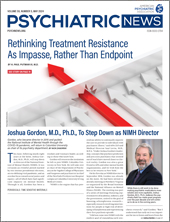Nearly one in five people who attempt suicide either have no history of prior mental illness or do not meet the criteria for a diagnosis of mental illness at the time of the attempt, a
study in
JAMA Psychiatry suggests.
“This finding challenges clinical notions of who is at risk for suicidal behavior and raises questions about the safety of limiting suicide risk screening to psychiatric populations,” wrote past APA President Maria A. Oquendo, M.D., Ph.D., Ruth Meltzer Professor and Chair of Psychiatry at the Perelman School of Medicine at the University of Pennsylvania, and colleagues.
Oquendo and colleagues analyzed data from 1,948 adults (66.8% female) aged 20 to 65 years with a history of suicide attempts who were surveyed between April 2012 and June 2013 in the U.S. National Epidemiologic Study of Addictions and Related Conditions III.
The researchers found that 6.2% of the respondents did not have a diagnosis of mental illness at any time prior to attempting suicide or afterwards up to the point they completed the survey. They also found that an additional 13.4% made a first suicide attempt before the onset of mental illness, and some did not meet the criteria for a mental illness until several years after their suicide attempt. All told, an estimated 19.6% of adults reported a lifetime suicide attempt with no evidence of a mental illness prior to their first attempt; this prevalence was approximately the same in males and females.
“I was surprised there were no differences in the frequency of suicide attempts with no psychiatric diagnosis based on sex or age,” Oquendo told
Psychiatric News. “I anticipated that we would find it to be more common in men.” Some
previous research has found that many males who died by suicide had no history of mental health problems, and the suicide was often preceded by an acute stressor like an argument.
Overall, the findings suggest that a history of suicide attempts should be obtained regardless of whether an individual has a psychiatric disorder, given that suicide attempts are associated with future attempts and future suicide, the researchers wrote.
“[P]olicy makers, clinicians, and health systems should weigh the costs and benefits of expanding suicide risk screening beyond the current targets and consider universal screening to prevent suicide attempts, which have significant morbidity as well as medical and other costs,” they added.
Regulatory bodies currently do not require or recommend screening for suicidal thoughts in the general population. For example, the Joint Commission’s
seven elements of performance for accredited hospitals, behavioral health care organizations, and critical access hospitals only require screening for suicidal ideation in individuals who present with psychiatric conditions. In a similar vein, although the
U.S. Preventive Services Task Force recommends screening for depression in all adults, it has stated that current evidence is “insufficient to assess the balance of benefits and harms of screening for suicide risk in the adult population.”
“It seems to me we may need to revisit that approach so we can do a better job at finding people at risk,” Oquendo said.
The researchers wrote that considering suicidal behavior a separate psychiatric disorder would lead to a uniform definition and a diagnostic code; this would make it easier to document suicide attempts as well as patients’ trajectory and response to treatment over time. “Additional benefits include a reconceptualization of suicide risk as a therapeutic target for which we have specific interventions, rather than thinking ‘if I treat the psychiatric diagnosis [that may be associated with suicidal ideation], the suicide risk will go away,’” Oquendo told Psychiatric News.
However, viewing suicidal behavior as a separate psychiatric disorder would also carry a few drawbacks, Oquendo said.
“Some suicidal behavior is related to cultural or political issues and may not be pathological per se. It could [also] create confusion about the ethics of medical assistance in dying,” she said.
For now, health professionals, including psychiatrists, need to be educated about the possibility of suicidal ideation in patients who do not have a psychiatric diagnosis, Oquendo said.
The researchers reported no outside funding for this study. ■


